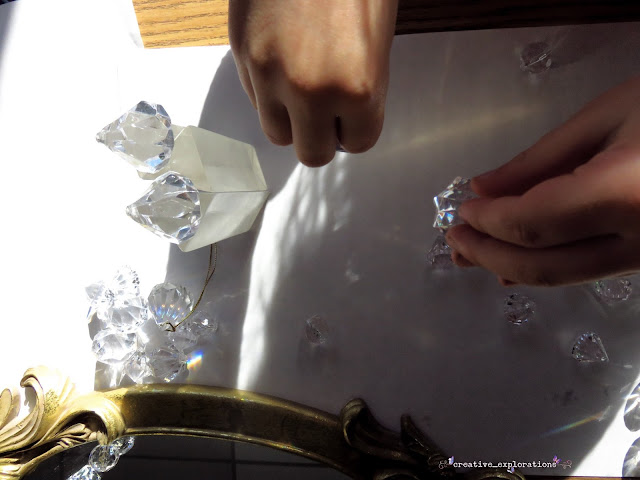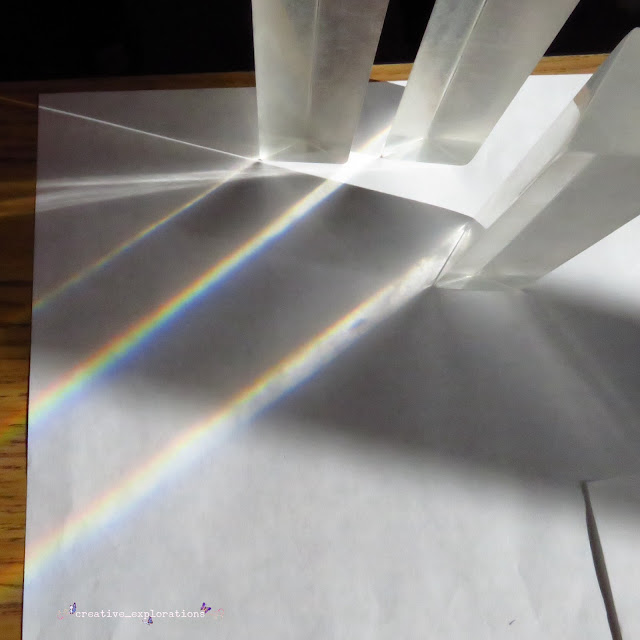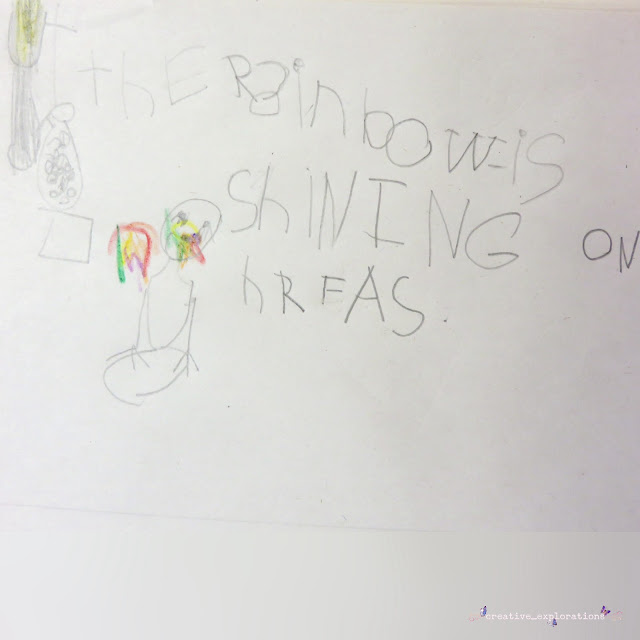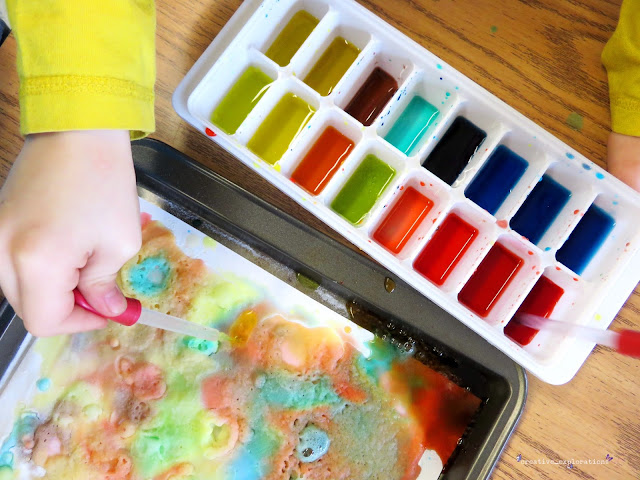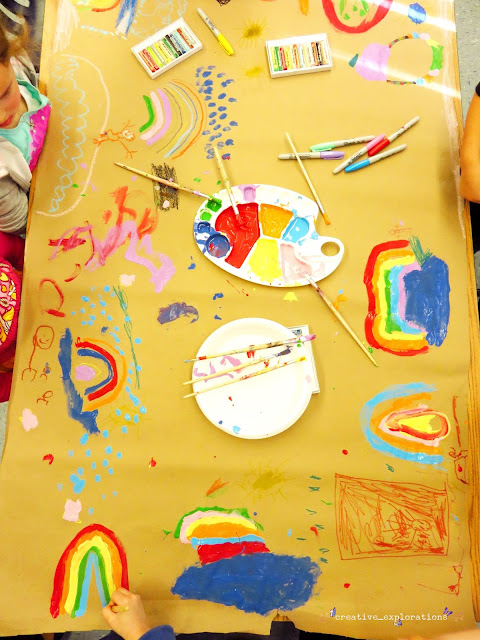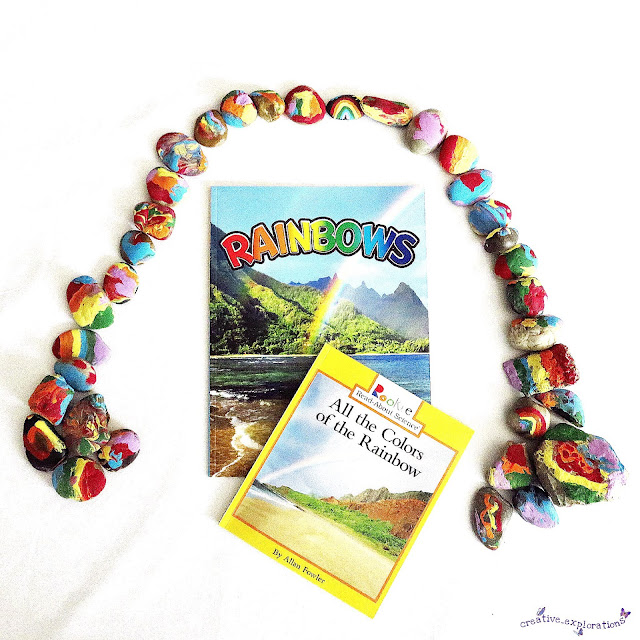"The magic of rainbows inspires those who are fortunate enough to catch a glimpse of one."
M. van Heugten
Rainbows certainly inspired our little learners and I am excited to share with you their investigations into nature's own paint palette.
On a beautiful sunny day the children were offered this invitation in the art studio. On the golden mirror was placed crystal facets of various sizes and the triangular prisms. Around the mirror I placed sheets of white paper as a work surface. This invitation was created in response to the children's interest and previous investigations into light.
Prisms and Rainbows Oh My!
Several children came to investigate the prisms and facets. They picked the prisms up and began to manipulate them in the sunlight. The children were so excited to find rainbows. They shared their enthusiasm with each other. One of the children observed, "The sun is really bright." We wondered what the children would think about the colour of the sun. We asked them to think about this question and they replied, "Yellow, and it comes off the sun and comes inside." Then they glanced out the window.
The children pointed to the rainbow created on the table's surface. They manipulated the prisms in the sunlight experimenting as they created the brightest rainbow they could.
Dancing Sunlight
The art studio at the table danced with the prisms and crystal facets. the children placed the crystal facets on the top of the prisms. Then one child held up the crystals by the strings and watched as they danced in the sunlight. She worked quietly observing the effects of her actions with the crystal facets. She moved the facets into a variety of positions and noticed how the pattern of reflected light changed with her movements.
The children concluded their initial work with the prisms and facets by discovering rainbows on their faces. Then they used several of the prisms to reflect multiple rainbows on their faces. We couldn't wait to see how they would extend their ideas the following day and they asked if we would set the invitation out again.
Coloured Sunlight
Catching a Rainbow
When I asked this group to share what they were doing one of the children explained, "We are trapping rainbows."
Looking at the sky!
Inquiry Spaces
Creating a space to WONDER!
Also included were materials focusing on colour and the question box papers for recording any new wonderings.
These rainbow beans are one of my favourite sensory bin bases and after four years they are still going strong.
I always love how the children take ownership of their own environment. Here are the stylings of one child after clean up. It also shows us their understanding of one to one correspondence and colour matching.
This loose parts rainbow tray was perhaps my favourite of the year. The children began to add their own items to the tray as well. The coloured tops to their squeezable applesauce were included.
The children explored with the loose parts tray for several weeks. Here we see how as we offered them other materials they began to bring them to the light panel and include them in their thinking.
Making Connections
The following day I moved the invitation to one of the tables in the other room. The prisms and crystal facets were set up for further exploration. The children began by placing the prisms on the edge of the table. As they were moving the prisms around they made a wonderful discovery. The sunlight coming through the window created a rainbow on the floor as it passed through the prism. They extended this discovery further by manipulating multiple prisms. You can see the progression of their efforts as they experimented and problem solved with these materials. Their focus was unwavering as they tried to create as many rainbows as they could on the floor. We were so impressed with how they handled the materials competently with a clear vision in mind. I did not interrupt them and just observed and documented their learning.
They manipulated the prisms to blend the colours of the rainbow to create new colours where the rainbows overlapped each other discovering the colour purple.
Catching a Rainbow
The children sustained this interest in rainbows and working with the prisms for several weeks. Of course, they could only work with the sunlight when the weather allowed on a sunny day. On cloudy days they focused on using the flashlights or continued other investigations in their play. However each sunny day they would return to this interest. After several days of working with the prisms investigating sunlight and rainbows, a few of the children decided to create a space for their rainbows. By this point in the investigation, several other children became interested and drawn into the work as well. They used stools to block off an area and set the prisms on the stools. They created several rainbows on the floor. They created signs with arrows and placed them throughout their space. The arrows were to direct people the go around their investigation area.
Clear bottles filled with water were also added to the materials for this exploration. They created beautiful arching rainbows in contrast to the straight rainbows created by the prisms.
When I asked this group to share what they were doing one of the children explained, "We are trapping rainbows."
Looking at the sky!
As the children continued their rainbow investigations we were noticing an interest in where rainbows come from. One of the children approached the educator during play block and wanted to go to the window. He said, "Look there is a hole in the sky." It was a cloudy day and there was not enough sunlight for the children to continue their rainbow work with the prisms. I documented the sky for him by taking a photo. He quickly noticed that the shape of the hole in the sky was changing. He also described the hole as really bright sunlight. I asked him if he would like to research rainbows on the iPad to help extend his ideas. He readily agreed and we moved to the table bringing paper and pencils along with the iPad. I asked him what he wanted to look up. He decided he wanted to see how he could make a rainbow. We found a YouTube video that showed several ways to create rainbows. I look forward to their shared learning presentation of their research to the class.
The following day we offered the photo of the sky to this child. I encouraged him to record thinking from the previous day. He printed on the whiteboard first and then transferred his writing to the paper.
"I notisb that the sun is shining out the clads."
We now felt that it was time to bring this learning and the investigations to the larger group of children. During our shared learning time, we presented the photos that we had documented and asked the children to share their ideas.
After sharing with the children their initial work with the prisms and sunlight we discussed their initial theories on rainbows. We looked forward to our continued investigations of this interest.
Inquiry Spaces
Creating a space to WONDER!
The children's observations were placed at the inquiry table with the book "Sky Color" by Peter H. Reynolds. We also added a CD based on the children's research on the iPad.
Also included were materials focusing on colour and the question box papers for recording any new wonderings.
These rainbow beans are one of my favourite sensory bin bases and after four years they are still going strong.
I always love how the children take ownership of their own environment. Here are the stylings of one child after clean up. It also shows us their understanding of one to one correspondence and colour matching.
This loose parts rainbow tray was perhaps my favourite of the year. The children began to add their own items to the tray as well. The coloured tops to their squeezable applesauce were included.
The children explored with the loose parts tray for several weeks. Here we see how as we offered them other materials they began to bring them to the light panel and include them in their thinking.
Making Connections
I had been posting some of the children's investigations and discoveries on Instagram and through this social media medium, we were fortunate to make an across the world connection. After posting one of the children's photos Jess Lam of @tinkertots.my on Instagram asked if we could collaborate with her students in her Reggio-inspired creative arts programme in Malaysia. The children in her class were asking how to create rainbows on their faces as part of their photography work. Jess suggested that I ask our students if they would show them how using the prisms. I asked the children and they were thrilled. I took a video of the children demonstrating how to use the prism to shine a rainbow on their hands. We sent the video to Jess and she shared it with her students. After watching the video her students used a CD and a flashlight to create a rainbow on their faces. Jess sent me the photos and I shared them with the children. How amazing it was for them to witness how their learning affected the learning of children all the way across the globe. Next, our children tried using the CD and flashlight to make rainbows on themselves just like the children in Malaysia. Then one of our students was inspired to record her learning in her journal. Documenting the photo from Jess's programme of the girl with the rainbow on her face. I felt so blessed to have been able to share this learning with both groups of children. Thank you Jess once again for your amazing and inspiring participation in our rainbow investigations. To see Jess' amazing program visit her blog: www.fosdq.com
At this point in our investigation, we began to read to the children the books we had placed throughout the learning space on rainbows. We felt that they had worked through some of their initial thinking and were now ready for new challenges and extensions to their ideas. Here are some of the books we shared with the children: "A rainbow of my own" by Don Freeman and "Rainbows never end and other fun facts" by Laura Lyn DiSiena and Hannah Eliot.
The two books we used the most were: "All the Colors of the Rainbow" by Allan Fowler and "Rainbows" by David Whitfield. These books were often carried around the classroom and referred to as the children investigated. I will have a photo of the covers of these two books at the end of this blog post.
We offered the children several experiences that focused on colours. The first was a colour mixing experiment using milk, food colouring and dish soap. After filling a pie plate with milk we dropped a few drops of the primary colours of food colouring in the milk. Then the children dipped the end of a cotton bud into dish soap. Next, they placed the tip into the milk and experimented. They loved this experience and asked to have it repeated several times. How exciting it was to see the colours mix together to make the secondary colours. It was painting, movement and colour theory all in one invitation.
Next, I wanted to extend the children's fascination with colour by extending their knowledge of colour theory. The children were pretty confident at knowing that red and yellow mixed together would create orange and so forth. But we wanted to give them the chance to explore tints and shades by adding white and black to the primary colours. In the art studio, I had placed a ring of paint chips for the children to investigate. However, no one seemed to be interested. I picked up a new set of paint chip cards and created this invitation to explore colour for the children. Below is the investigations of two separate groups over two days. The children that chose to explore the paint here never left this invitation the entire play block. Their discussion was rich with how the paint blended together and each day was a completely different exploration. I hope you enjoy seeing how they used the paint chips for inspiration and how they guided their learning about colour and paint.
This next invitation combined science and art. It is always very popular with the children as it activates several of their senses. It is the baking soda and coloured vinegar experiment. Before inviting the children to the table to explore we gathered on the carpet to read the text, "Mouse Paint" by Ellen Stoll Walsh. The children enjoyed listening to the story and the illustrations were lovely. Next, they were given the instructions for the colour invitation. I set up two trays one on each end of the long rectangular tables. Soon there was a flurry of interest in investigating here. We repeated this invitation for several days. When one tray was completed we set it in the art studio to dry. After several days we had four colourful trays. I offered the trays back to the children for investigation. They could not believe how hard the baking soda had become. Immediately they began to bang with their fist to break it apart and remove it from the tray. How lovely it was to find the beautiful rainbow coloured paper underneath. I offered them a shallow dishpan to collect the baking soda pieces in. Over the next few days, they continued to play with the baking soda until it had returned to its original powdery state. Their investigation had come full circle.
Supporting an interest with the art!
We created for the children an opportunity for them to work collaboratively together on two different art invitations. The first involved using clear sticky tack paper and collage materials from the art studio. Our hope was to further their ideas about colour and light by creating a piece which we could hang in the window. Several children created together using the materials offered and we celebrated their ideas and efforts by proudly displaying their art piece.
The children cut page dividers into shapes and placed them on the contact paper.
Our finished collage piece hangs in the art studio window.
The rainbow mural was completed over several days. The children were encouraged to show us their understanding of rainbows. Several children included the sun and rain with their rainbows displaying their knowledge of how rainbows are formed. Other children were very specific about the order of the colours in the rainbow. Still, other children drew about their experiences with seeing rainbows.
When the children had completed the rainbow mural we hung it on the classroom board to celebrate all that they had learned about rainbows.
It seems fitting to conclude this blog post with the three children who began this investigation into rainbows. Here they are working on the floor drawing rainbows during their play. The children drew several pages of rainbows before deciding on which ones to include in the art studio. They placed their finished papers in the art studio with prisms carefully sitting by their hand-drawn rainbows. A beautiful conclusion to their learning.
Spreading Kindness
We were also inspired by @hellowonderful.co and her daughter's @rainbowrockproject on Instagram to make our own rainbow rocks. How wonderful it was to take the children's interest and relate it to something so meaningful and important. We first painted the rocks and then printed words of encouragement on the back. The children delivered their rainbow rocks around the school to each classroom. We were so inspired by Agnes and her daughter Alia and their journey to spread kindness. I encourage you to check out this wonderful project and pass on your own kindness.
www.hellowonderful.co
www.rainbowrockproject.com
I leave you with this Irish blessing:
"May flowers always line your path
and sunshine light your day.
May song birds serenade you
every step along the way.
May a rainbow run beside you
in a sky that's always blue.
And may happiness fill your heart
each day your whole life through."







